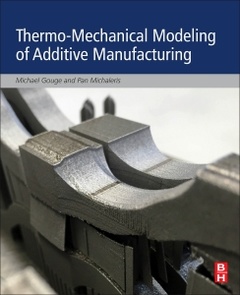Thermo-Mechanical Modeling of Additive Manufacturing
Coordonnateurs : Gouge Michael, Michaleris Pan

Thermo-mechanical Modeling of Additive Manufacturingprovides the background, methodology and description of modeling techniques to enable the reader to perform their own accurate and reliable simulations of any additive process. Part I provides an in depth introduction to the fundamentals of additive manufacturing modeling, a description of adaptive mesh strategies, a thorough description of thermal losses and a discussion of residual stress and distortion. Part II applies the engineering fundamentals to direct energy deposition processes including laser cladding, LENS builds, large electron beam parts and an exploration of residual stress and deformation mitigation strategies. Part III concerns the thermo-mechanical modeling of powder bed processes with a description of the heat input model, classical thermo-mechanical modeling, and part scale modeling.
The book serves as an essential reference for engineers and technicians in both industry and academia, performing both research and full-scale production. Additive manufacturing processes are revolutionizing production throughout industry. These technologies enable the cost-effective manufacture of small lot parts, rapid repair of damaged components and construction of previously impossible-to-produce geometries. However, the large thermal gradients inherent in these processes incur large residual stresses and mechanical distortion, which can push the finished component out of engineering tolerance. Costly trial-and-error methods are commonly used for failure mitigation. Finite element modeling provides a compelling alternative, allowing for the prediction of residual stresses and distortion, and thus a tool to investigate methods of failure mitigation prior to building.
Part I The fundamentals of additive manufacturing modeling 1. An introduction to additive manufacturing processes and their modeling challenges Michael Fielding Gouge, Pan Michaleris 2. The Finite Element Method for the Thermo-Mechanical Modeling of Additive Manufacturing Processes Erik Denlinger, Jeff Irwin, Michael Fielding Gouge
Part II Thermomechanical modeling of Direct Energy Deposition processes 3. Convection Boundary Losses During Laser Cladding Michael Fielding Gouge 4. Conduction Losses due to Part Fixturing During Laser Cladding Michael Fielding Gouge 5. Microstructure and Material Properties of AM Builds Allison Michelle Beese 6. Understanding microstructure evolution during additive manufacturing of metallic alloys using phase-field modeling Yanzhou Ji, Lei Chen, Long-Qing Chen 7. Modeling Microstructure and Material Properties of AM Processes Using the FE Method Jeff Irwin 8. Thermo-mechanical Modeling of Thin Wall Builds Using the Direct Process Jarred Heigel 9. Residual Stress and Distortion Modeling of Electron Beam Direct Manufacturing Ti-6Al-4V Erik Denlinger 10. Thermo-mechanical Modeling of Large Electron Beam Builds Erik Denlinger 11. Mitigation of Distortion in Large Additive Manufacturing Parts Erik Denlinger
Part III Thermomechanical modeling of powder bed processes 12. Development and Numerical Verification of an Adaptive Mesh Coarsening Strategy for Simulating Laser Powder Bed Fusion Processes Erik Denlinge 13. Experimental Validation for In Situ Distortion Modeling of the Laser Powder Bed Fusion Process Erik Denlinger 14. Scan Pattern Effects in Laser Powder Bed Fusion Processes: In Situ Measurements and Experimental Validation Alexander Dunbar 15. Experimental Validation of Multi-scale Thermo-mechanical Modeling of Laser Powder Bed Fusion Processe Jeff Irwin, Michael Fielding Gouge
Pan Michaleris is a Senior Software Architect at Autodesk Inc. He received his Ph.D. in 1994 in theoretical and applied mechanics at the University of Illinois at Urbana-Champaign, and was a senior research engineer at the Edison Welding Institute (EWI) until 1997. Pan served as a professor in the Mechanical and Nuclear Engineering Department at the Pennsylvania State University from 1997-2016. In 2012, Michaleris founded and served as both president and lead developer at Pan Computing LLC. Pan Computing was a software development and commercialization company for physics-based modeling of additive manufacturing processes. Pan Computing was acquired by Autodesk Inc. in 2016. His areas of interest include computational mechanics, finite element methods, manufacturing process modeling, and residual stress and distortion. Michaleris authored Minimization of Welding Distortion and Buckling and in addition to more than 80 peer reviewed journal and proceedings papers. He formerly served on the editorial board of Science and Technology in Welding and Joining, and was an associate editor for Welding Journal.
- Provides understanding of important components in the finite element modeling of additive manufacturing processes necessary to obtain accurate results
- Offers a deeper understanding of how the thermal gradients inherent in additive manufacturing induce distortion and residual stresses, and how to mitigate these undesirable phenomena
- Includes a set of strategies for the modeler to improve computational efficiency when simulating various additive manufacturing processes
- Serves as an essential reference for engineers and technicians in both industry and academia
Date de parution : 08-2017
Ouvrage de 294 p.
19x23.3 cm



